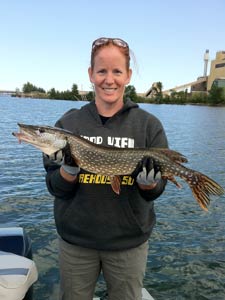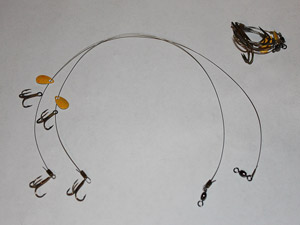
Fishing with live bait presentations has always been a proven method for catching just about anything that swims, especially walleye, pike and muskie. Unfortunately, with these methods the majority of fish that get caught are usually required to be harvested due to baits and fishing hooks getting swallowed. With catch and release ideals becoming increasingly popular among sport fisherman, different techniques have been created to help anglers catch and return more fish to their favorite bodies of water.
 |
| The pike quick strike rig allows anglers to have more catch and release fish. |
The quick strike rig is one of these special techniques that allow anglers to detect strikes, get immediate hook sets and have good percentages of hookups with fish. One of the biggest benefits of the quick strike rig is that anglers do not have to wait for fish to swallow the bait, which in turn leads to more lip-hooked fish and a lot more releasable fish. Quick strike rigs can add a new element to your fishing arsenal, especially when the bite get tough.
Keys to the Quick Strike Rig
As is the case with many other live baits rigs, there are a few keys that makes the quick strike rig so successful. First and foremost the hooks used in these rigs have to be quality hooks. Thick shank trebles are a must so that straightening or twisting does not occur when they get put under pressure. Secondly the size of the hook is very important. Large hooks have always been perceived to be ideal if you are fishing for large fish. Recently it has been shown that these larger hooks (larger hook points) make it harder to sink the hook into a bony fishes mouth. Smaller hooks are easier to set (less pressure needed to become lodged) and hold better while the fish thrashes about violently. One key to judging which hooks to use when you setup is to select trebles that are just big enough to have exposed hook points after being placed in a minnow.
The table below is a general comparison of the hook size to minnow length that should be used with quick strike rigs:
| Hook Size | Minnow Length |
| #1 Treble Hook | 5-10 inches |
| #1/0 to #2/0 Treble Hook | 11-14 inches |
| #2/0 to #3/0 Treble Hook | 15-18 inches |
Quick Strike Fishing Rig Construction
The quick strike rig consists of a few basic fishing components: swivel, wire, hooks and a blade. The uncoated stranded wire is normally 20- to 40-pound test and can be different lengths between 12 to 24 inches. The front treble should be small and the rear treble should be heavy duty. High quality rigs will incorporate shrink wrap tubing around the front hook shank so that it will slide on the wire making it adjustable. A small colored or metallic spinner blade can also be added to these rigs giving them a bit more flash or attractant to entice fish.
Quick Strike Rigging
 |
| The quick strike rig consists of a swivel, wire, hooks and a blade. |
Hook placement with your live bait is critical when using the quick strike rig. Many fisherman nose hook or dorsal fin hook minnows, and the success rate of these single hooked baits are very low. The key to quick strike rigs is that you have the ability to position your hook in the bait so that regardless of where the fish strikes they should come into contact with at least one of your hooks. Placing one hook as far forward on the bait is a good choice (nose/cheek area) and the second hook should be 1/4 to 1/2 inch behind the dorsal fin. Make sure that when you are seating your hooks that you don't bury the hook gape. Place them so that the majority of the hook point is exposed and they can tear out very easily.
Using the Quick Strike Rig
Once you have the bait rigged the last thing you have to figure out is how to set the line and fishing rod to detect strikes. Hanging quick strike rigs from bobbers or tip ups works great but when you are fishing an area that has an uneven bottom of changing depths free-lining minnows works the best. Don't be afraid to work your quick strike rigs along drop-offs, stumps, logs or rocks. If you are free-lining with this rig and your line has any type of movement, bounce or stop that doesn't seem normal, set the hook hard.
Minnow harnesses and other types of live bait rigs have been used for decades by anglers all over the world. Quick strike rigs are just the newest adaptations of these fish catching methods. Characteristics like versatility, quick hook sets and great live release rates make these rigs a necessity for any serious fisherman.
- 18847 views

